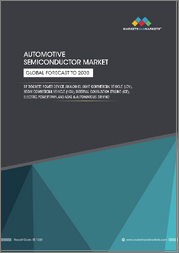
|
시장보고서
상품코드
1687550
자동차용 반도체 시장 규모, 점유율, 성장 분석 : 컴포넌트별, 차종별, 용도별, 지역별 - 산업 예측(2025-2032년)Automotive Semiconductor Market Size, Share, and Growth Analysis, By Component (Processors, Sensors), By Vehicle Type (Passenger Vehicles, Light Commercial Vehicles (LCV)), By Application, By Region - Industry Forecast 2025-2032 |
||||||
세계의 자동차용 반도체 시장 규모는 2023년에 700억 달러로 평가되며, 2024년 759억 5,000만 달러에서 2032년에는 1,458억 7,000만 달러로 성장하며, 예측 기간(2025-2032년)의 CAGR은 8.5%로 성장할 전망입니다.
자동차 부문의 전동화는 자동차 전용으로 설계된 칩과 집적회로를 포함한 자동차용 반도체 수요를 크게 증가시킬 것으로 예상됩니다. 최신 자동차에는 첨단 디지털 기술과 첨단 센서가 내장되어 있으며, 이 시장의 매출을 견인하고 있습니다. 새로운 자동차용 반도체 개발에 대한 대규모 투자는 시장 확대를 더욱 촉진할 것으로 보입니다. 또한 전 세계에서 반도체 기술이 발전하고 있으므로 예측 기간 중과 그 이후에도 수요가 확대될 것으로 예상됩니다. 그러나 제조 비용의 상승과 규제 준수 문제 등의 이슈가 장기적으로는 매출에 걸림돌이 될 수 있습니다. 전반적으로 기회는 풍부하지만, 이해관계자들은 시장의 잠재력을 충분히 활용하기 위해 이러한 장애물을 극복해야 합니다.
목차
서론
- 조사의 목적
- 조사 범위
- 정의
조사 방법
- 정보 조달
- 2차와 1차 데이터 방법
- 시장 규모 예측
- 시장의 전제조건과 제한
개요
- 세계 시장 전망
- 공급과 수요 동향 분석
- 부문별 기회 분석
시장 역학과 전망
- 시장 개요
- 시장 규모
- 시장 역학
- 촉진요인과 기회
- 억제요인과 과제
- Porter의 산업 분석
주요 시장 인사이트
- 주요 성공 요인
- 경쟁의 정도
- 주요 투자 기회
- 시장 에코시스템
- 시장의 매력 지수(2024년)
- PESTEL 분석
- 거시경제 지표
- 밸류체인 분석
- 가격 분석
- 사례 연구
- 규제 상황
자동차용 반도체 시장 규모 : 컴포넌트별 & CAGR(2025-2032)
- 시장 개요
- 프로세서
- 센서
- 메모리 디바이스
- 집적회로
- 디스크리트 파워 디바이스
- RF 디바이스
자동차용 반도체 시장 규모 : 차종별 & CAGR(2025-2032)
- 시장 개요
- 승용차
- 소형 상용차(LCV)
- 대형 상용차(HCV)
자동차용 반도체 시장 규모 : 용도별 & CAGR(2025-2032)
- 시장 개요
- 섀시
- 파워 일렉트로닉스
- 안전성
- 보디 일렉트로닉스
- 쾌적/엔터테인먼트 유닛
- 기타 용도
자동차용 반도체 시장 규모 : 지역별 & CAGR(2025-2032)
- 북미
- 미국
- 캐나다
- 유럽
- 독일
- 스페인
- 프랑스
- 영국
- 이탈리아
- 기타 유럽 지역
- 아시아태평양
- 중국
- 인도
- 일본
- 한국
- 기타 아시아태평양
- 라틴아메리카
- 브라질
- 기타 라틴아메리카 지역
- 중동 및 아프리카
- GCC 국가
- 남아프리카공화국
- 기타 중동 및 아프리카
경쟁 정보
- 상위 5사의 비교
- 주요 기업의 시장 포지셔닝(2024년)
- 주요 시장 기업이 채택한 전략
- 최근 시장 동향
- 기업의 시장 점유율 분석(2024년)
- 주요 기업의 기업 개요
- 기업의 상세
- 제품 포트폴리오 분석
- 기업의 부문별 점유율 분석
- 매출의 전년대비 비교(2022-2024)
주요 기업 개요
- Infineon Technologies(Germany)
- NXP Semiconductors(Netherlands)
- Renesas Electronics(Japan)
- Texas Instruments(United States)
- STMicroelectronics(Switzerland)
- ON Semiconductor(United States)
- Robert Bosch GmbH(Germany)
- Analog Devices(United States)
- Micron Technology(United States)
- Qualcomm(United States)
- NVIDIA(United States)
- Broadcom(United States)
- Samsung Electronics(South Korea)
- Toshiba(Japan)
- Intel(United States)
- Rohm Semiconductor(Japan)
- Microchip Technology(United States)
- Marvell Technology(United States)
- MediaTek(Taiwan)
- SK Hynix(South Korea)
결론과 제안
KSA 25.04.24Global Automotive Semiconductor Market size was valued at USD 70.0 billion in 2023 and is poised to grow from USD 75.95 billion in 2024 to USD 145.87 billion by 2032, growing at a CAGR of 8.5% during the forecast period (2025-2032).
The electrification of the automotive sector is poised to drive significant growth in automotive semiconductor demand, which encompasses chips and integrated circuits specifically designed for vehicles. The integration of advanced digital technologies and sophisticated sensors in modern automobiles is propelling sales in this market. Substantial investments in the development of new automotive-specific semiconductors will further enhance market expansion. Additionally, ongoing advancements in semiconductor technology globally are set to amplify demand throughout the forecast period and beyond. However, challenges such as high manufacturing costs and regulatory compliance issues may inhibit sales in the long term. Overall, while opportunities abound, stakeholders must navigate these hurdles to fully capitalize on the market's potential.
Top-down and bottom-up approaches were used to estimate and validate the size of the Global Automotive Semiconductor market and to estimate the size of various other dependent submarkets. The research methodology used to estimate the market size includes the following details: The key players in the market were identified through secondary research, and their market shares in the respective regions were determined through primary and secondary research. This entire procedure includes the study of the annual and financial reports of the top market players and extensive interviews for key insights from industry leaders such as CEOs, VPs, directors, and marketing executives. All percentage shares split, and breakdowns were determined using secondary sources and verified through Primary sources. All possible parameters that affect the markets covered in this research study have been accounted for, viewed in extensive detail, verified through primary research, and analyzed to get the final quantitative and qualitative data.
Global Automotive Semiconductor Market Segments Analysis
Global Automotive Semiconductor Market is segmented by Component, Vehicle Type, Application and region. Based on Component, the market is segmented into Processors, Sensors, Memory Devices, Integrated Circuits, Discrete Power Devices and RF Devices. Based on Vehicle Type, the market is segmented into Passenger Vehicles, Light Commercial Vehicles (LCV) and Heavy Commercial Vehicles (HCV). Based on Application, the market is segmented into Chassis, Power Electronics, Safety, Body Electronics, Comfort/Entertainment Unit and Other Applications. Based on region, the market is segmented into North America, Europe, Asia Pacific, Latin America and Middle East & Africa.
Driver of the Global Automotive Semiconductor Market
The Global Automotive Semiconductor market is significantly influenced by the growing focus on sustainability and the rapid progress in battery technology, which have collectively boosted the appeal of electric vehicles (EVs). As more consumers and manufacturers shift towards eco-friendly transportation solutions, the demand for automotive semiconductors is expected to surge, particularly in relation to EVs. This trend underscores the industry's commitment to innovation and green technology, positioning automotive semiconductors as a critical component in the advancement of electric mobility. Consequently, the accelerating adoption of electric vehicles is anticipated to be a major driver for growth in the automotive semiconductor sector moving forward.
Restraints in the Global Automotive Semiconductor Market
The global automotive semiconductor market faces significant restraints due to the high manufacturing costs associated with producing semiconductors specifically for automotive applications. Not many companies possess the necessary resources and infrastructure to develop semiconductor products from the ground up, which poses a barrier to entry for new players in the market. This situation creates an environment where the financial burden may hinder the growth of automotive semiconductor demand, as fewer companies can afford to invest in their development. Consequently, the overall outlook for demand in this sector may be negatively impacted by these financial constraints, limiting market expansion opportunities.
Market Trends of the Global Automotive Semiconductor Market
The Global Automotive Semiconductor market is witnessing a significant trend driven by the rapid digitization of the automotive industry alongside increasing cybersecurity threats. As vehicles become more connected and reliant on sophisticated electronic systems, the demand for automotive semiconductors equipped with advanced security features is surging. Companies are compelled to innovate and enhance the resilience of their semiconductor solutions to mitigate risks associated with cyberattacks. This focus on cybersecurity not only safeguards vehicle integrity but also ensures regulatory compliance and consumer trust. Consequently, investments in secure automotive semiconductors are becoming a competitive differentiator, positioning firms favorably in a rapidly evolving market landscape.
Table of Contents
Introduction
- Objectives of the Study
- Scope of the Report
- Definitions
Research Methodology
- Information Procurement
- Secondary & Primary Data Methods
- Market Size Estimation
- Market Assumptions & Limitations
Executive Summary
- Global Market Outlook
- Supply & Demand Trend Analysis
- Segmental Opportunity Analysis
Market Dynamics & Outlook
- Market Overview
- Market Size
- Market Dynamics
- Drivers & Opportunities
- Restraints & Challenges
- Porters Analysis
- Competitive rivalry
- Threat of substitute
- Bargaining power of buyers
- Threat of new entrants
- Bargaining power of suppliers
Key Market Insights
- Key Success Factors
- Degree of Competition
- Top Investment Pockets
- Market Ecosystem
- Market Attractiveness Index, 2024
- PESTEL Analysis
- Macro-Economic Indicators
- Value Chain Analysis
- Pricing Analysis
- Case Studies
- Regulatory Landscape
Global Automotive Semiconductor Market Size by Component & CAGR (2025-2032)
- Market Overview
- Processors
- Sensors
- Memory Devices
- Integrated Circuits
- Discrete Power Devices
- RF Devices
Global Automotive Semiconductor Market Size by Vehicle Type & CAGR (2025-2032)
- Market Overview
- Passenger Vehicles
- Light Commercial Vehicles (LCV)
- Heavy Commercial Vehicles (HCV)
Global Automotive Semiconductor Market Size by Application & CAGR (2025-2032)
- Market Overview
- Chassis
- Power Electronics
- Safety
- Body Electronics
- Comfort/Entertainment Unit
- Other Applications
Global Automotive Semiconductor Market Size & CAGR (2025-2032)
- North America (Component, Vehicle Type, Application)
- US
- Canada
- Europe (Component, Vehicle Type, Application)
- Germany
- Spain
- France
- UK
- Italy
- Rest of Europe
- Asia Pacific (Component, Vehicle Type, Application)
- China
- India
- Japan
- South Korea
- Rest of Asia-Pacific
- Latin America (Component, Vehicle Type, Application)
- Brazil
- Rest of Latin America
- Middle East & Africa (Component, Vehicle Type, Application)
- GCC Countries
- South Africa
- Rest of Middle East & Africa
Competitive Intelligence
- Top 5 Player Comparison
- Market Positioning of Key Players, 2024
- Strategies Adopted by Key Market Players
- Recent Developments in the Market
- Company Market Share Analysis, 2024
- Company Profiles of All Key Players
- Company Details
- Product Portfolio Analysis
- Company's Segmental Share Analysis
- Revenue Y-O-Y Comparison (2022-2024)
Key Company Profiles
- Infineon Technologies (Germany)
- Company Overview
- Business Segment Overview
- Financial Updates
- Key Developments
- NXP Semiconductors (Netherlands)
- Company Overview
- Business Segment Overview
- Financial Updates
- Key Developments
- Renesas Electronics (Japan)
- Company Overview
- Business Segment Overview
- Financial Updates
- Key Developments
- Texas Instruments (United States)
- Company Overview
- Business Segment Overview
- Financial Updates
- Key Developments
- STMicroelectronics (Switzerland)
- Company Overview
- Business Segment Overview
- Financial Updates
- Key Developments
- ON Semiconductor (United States)
- Company Overview
- Business Segment Overview
- Financial Updates
- Key Developments
- Robert Bosch GmbH (Germany)
- Company Overview
- Business Segment Overview
- Financial Updates
- Key Developments
- Analog Devices (United States)
- Company Overview
- Business Segment Overview
- Financial Updates
- Key Developments
- Micron Technology (United States)
- Company Overview
- Business Segment Overview
- Financial Updates
- Key Developments
- Qualcomm (United States)
- Company Overview
- Business Segment Overview
- Financial Updates
- Key Developments
- NVIDIA (United States)
- Company Overview
- Business Segment Overview
- Financial Updates
- Key Developments
- Broadcom (United States)
- Company Overview
- Business Segment Overview
- Financial Updates
- Key Developments
- Samsung Electronics (South Korea)
- Company Overview
- Business Segment Overview
- Financial Updates
- Key Developments
- Toshiba (Japan)
- Company Overview
- Business Segment Overview
- Financial Updates
- Key Developments
- Intel (United States)
- Company Overview
- Business Segment Overview
- Financial Updates
- Key Developments
- Rohm Semiconductor (Japan)
- Company Overview
- Business Segment Overview
- Financial Updates
- Key Developments
- Microchip Technology (United States)
- Company Overview
- Business Segment Overview
- Financial Updates
- Key Developments
- Marvell Technology (United States)
- Company Overview
- Business Segment Overview
- Financial Updates
- Key Developments
- MediaTek (Taiwan)
- Company Overview
- Business Segment Overview
- Financial Updates
- Key Developments
- SK Hynix (South Korea)
- Company Overview
- Business Segment Overview
- Financial Updates
- Key Developments



















